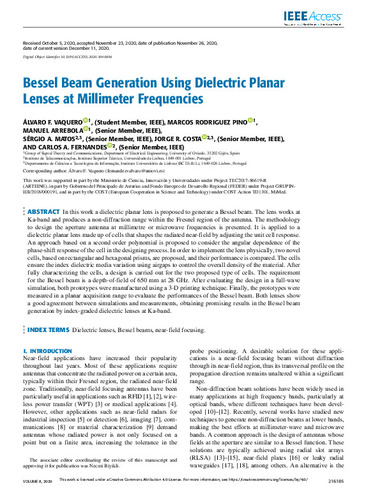Bessel Beam Generation Using Dielectric Planar Lenses at Millimeter Frequencies
Palabra(s) clave:
Dielectric lenses
Bessel beams
near-field focusing
Fecha de publicación:
Versión del editor:
Citación:
Descripción física:
Resumen:
In this work a dielectric planar lens is proposed to generate a Bessel beam. The lens works atKa-band and produces a non-diffraction range within the Fresnel region of the antenna. The methodologyto design the aperture antenna at millimetre or microwave frequencies is presented. It is applied to adielectric planar lens made up of cells that shapes the radiated near-field by adjusting the unit cell response.An approach based on a second order polynomial is proposed to consider the angular dependence of thephase-shift response of the cell in the designing process. In order to implement the lens physically, two novelcells, based on rectangular and hexagonal prisms, are proposed, and their performance is compared. The cellsensure the index dielectric media variation using airgaps to control the overall density of the material. Afterfully characterizing the cells, a design is carried out for the two proposed type of cells. The requirementfor the Bessel beam is a depth-of-field of 650 mm at 28 GHz. After evaluating the design in a full-wavesimulation, both prototypes were manufactured using a 3-D printing technique. Finally, the prototypes weremeasured in a planar acquisition range to evaluate the performances of the Bessel beam. Both lenses showa good agreement between simulations and measurements, obtaining promising results in the Bessel beamgeneration by index-graded dielectric lenses at Ka-band.
In this work a dielectric planar lens is proposed to generate a Bessel beam. The lens works atKa-band and produces a non-diffraction range within the Fresnel region of the antenna. The methodologyto design the aperture antenna at millimetre or microwave frequencies is presented. It is applied to adielectric planar lens made up of cells that shapes the radiated near-field by adjusting the unit cell response.An approach based on a second order polynomial is proposed to consider the angular dependence of thephase-shift response of the cell in the designing process. In order to implement the lens physically, two novelcells, based on rectangular and hexagonal prisms, are proposed, and their performance is compared. The cellsensure the index dielectric media variation using airgaps to control the overall density of the material. Afterfully characterizing the cells, a design is carried out for the two proposed type of cells. The requirementfor the Bessel beam is a depth-of-field of 650 mm at 28 GHz. After evaluating the design in a full-wavesimulation, both prototypes were manufactured using a 3-D printing technique. Finally, the prototypes weremeasured in a planar acquisition range to evaluate the performances of the Bessel beam. Both lenses showa good agreement between simulations and measurements, obtaining promising results in the Bessel beamgeneration by index-graded dielectric lenses at Ka-band.
Patrocinado por:
This work was supported in part by the Ministerio de Ciencia, Innovación y Universidades under Project TEC2017-86619-R(ARTEINE), in part by Gobierno del Principado de Asturias and Fondo Europeo de Desarrollo Regional (FEDER) under Project ject GRUPIN-IDI/2018/000191, and in part by the COST (European Cooperation in Science and Technology) under COST Action TD1301, MiMed.
Colecciones
Ficheros en el ítem





